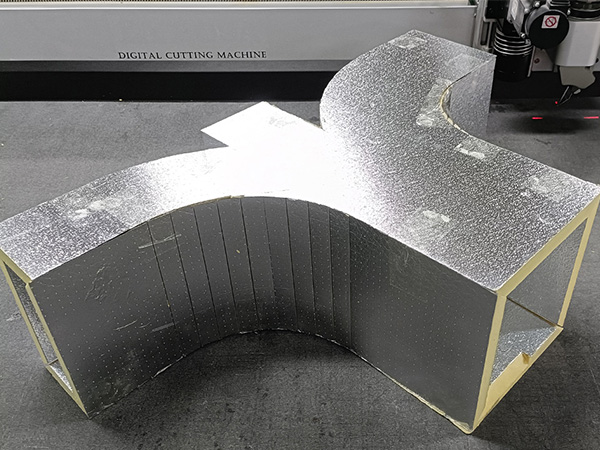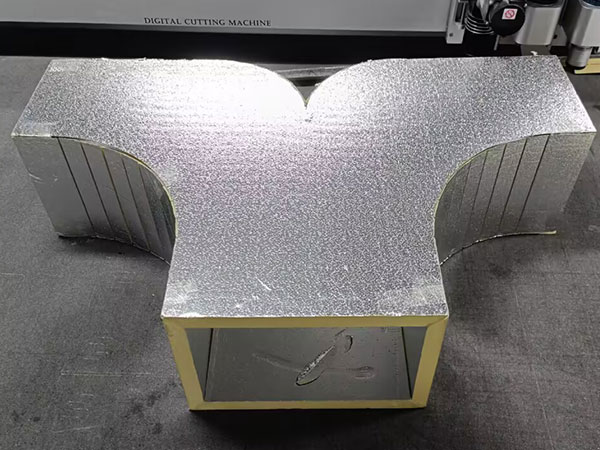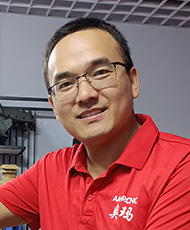1. What Are Pre-Insulated Phenolic Ducts?
Pre-insulated phenolic ducts are made by bonding phenolic foam boards with aluminum foil to create a sandwich panel. These ducts offer significant advantages:
- Thermal Insulation: With thermal conductivity as low as 0.016–0.036 W/(m·K), they drastically reduce energy loss compared to traditional materials.
- Noise Reduction: Phenolic foam’s porous structure provides excellent sound insulation, minimizing HVAC system noise.
- Lightweight and Durable: At 1.4 kg/m², phenolic ducts are much lighter than galvanized steel (7.08 kg/m²) or fiberglass ducts (15–20 kg/m²), making them easier to install and less burdensome for building structures.

2. Key Steps in Manufacturing Pre-Insulated Phenolic Ducts
Manual Production Process
- Design and Layout:
- Determine specifications for straight and custom ducts.
- Draw precise cutting lines and V-groove marks on the phenolic panels.
- Cutting and Shaping:
- Use tools like steel rulers, cutting knives, and beveling tools to manually cut the panels.
- For angled cuts, ensure the blade is tilted at 45° for a clean V-groove.
- Assembly and Sealing:
- Join panels with adhesive.
- Seal joints with aluminum foil tape and install flanges for airtightness.
- Installation:
- Hang the ducts with appropriate supports, ensuring stability and alignment.

Automated Production Process with CNC Machines
Using an Automatic Pre-Insulated Duct Cutting Machine streamlines the process:
- Digital Design:
- Retrieve duct shapes (straight ducts, elbows, T-joints, etc.) from preloaded libraries.
- Input measurements to generate 3D previews and export designs as DXF files.
- Nesting Optimization:
- Use software to optimize panel layouts, minimizing material waste and maximizing efficiency.
- Automated Cutting:
- Load the design into the machine, which uses oscillating knives for precise cuts, grooves, and angled cuts.
- Assembly and Finishing:
- Assemble and seal the ducts as described in the manual process but with perfectly cut components.
3. Why Choose CNC Machines for Phenolic Duct Production?
Precision and Consistency
CNC machines ensure uniform cuts and grooves, eliminating human errors commonly encountered in manual production.
Speed and Efficiency
Automated machines can complete complex layouts in seconds, drastically reducing production time.
Material Optimization
With advanced nesting algorithms, CNC machines maximize material utilization, reducing waste and cost.
Versatility
The machines can process various shapes (elbows, T-joints, Y-joints) and accommodate multiple panel thicknesses, from 20mm to 25mm.
Durability and Clean Finish
CNC machines produce smooth, burr-free edges that enhance duct longevity and aesthetic appeal.

4. Key Advantages of CNC Machines over Manual Methods
| Aspect | Manual Process | CNC Machines |
|---|---|---|
| Precision | Dependent on operator skill | High precision with consistent results |
| Speed | Time-consuming | Rapid processing |
| Material Efficiency | Significant waste | Optimized nesting for minimal waste |
| Customization | Limited | Easily handles complex shapes and designs |
| Labor Requirements | High | Reduced labor with automated operation |
| Finish Quality | May require rework | Clean, professional finish |
5. How CNC Machines Transform Phenolic Duct Manufacturing
By integrating advanced features like oscillating knife tools, CNC machines have revolutionized phenolic duct manufacturing. These machines allow HVAC businesses to:
- Increase production capacity without compromising quality.
- Meet the demand for complex, customized duct designs.
- Save costs by reducing material waste and labor requirements.

6. Conclusion
Phenolic ducts are the future of efficient, durable HVAC systems. While manual methods may still be viable for small-scale projects, adopting an Automatic Pre-Insulated Duct Cutting Machine offers unparalleled advantages in speed, precision, and material utilization. By leveraging CNC technology, manufacturers can deliver superior phenolic ducts that meet the exacting standards of modern construction.
For those looking to upgrade their production process, investing in a CNC cutting machine is a decision that guarantees long-term returns and satisfied customers.



